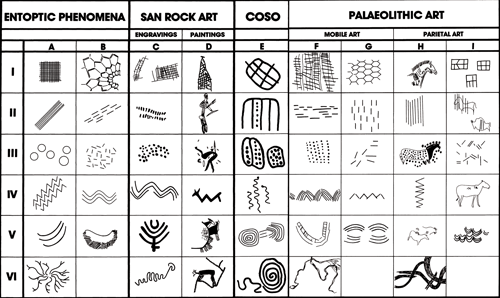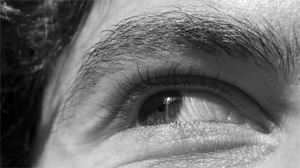Entoptic phenomena as universal trance phenomena
abracad, · Categories: consciousness, entoptic phenomena, externally authoredby Floco Tausin
In the mid-1990s I met a man named Nestor living in the solitude of the hilly Emmental region of Switzerland. Nestor has a unique and provocative claim: that he focuses for years on a constellation of huge shining spheres and strings which have been formed in his field of vision. He interprets this phenomenon as a subtle structure formed by our consciousness which in turn creates our material world. Nestor, who calls himself a seer, ascribes this subjective visual perception to his long lasting efforts to develop his consciousness. He explains his vision as an extended perception of a phenomenon for which, in ophthalmology, the collective term “floaters†is applied.
In ophthalmology, eye floaters are generally regarded as harmless vitreous opacities. They are “entoptic phenomenaâ€, viz. optical phenomena which are caused by certain conditions of the human visual system. Entoptic phenomena, whose appearance can be manipulated by selectively induced changes of consciousness states, are objects of interest for both science- and spiritually-oriented researchers. As physical and neurological symptoms, they belong to the physicians’ area of study; as subjective light phenomena they are likely to gain spiritual meanings for people like Nestor. While the Western medical study of entoptics has a tradition of a couple of hundred years, the interpretation of entoptic phenomena like floaters as spiritually significant perception in connection with altered states of consciousness possibly originated in the early days of human art.
Stone age rock art as entoptic phenomena – a study
In the 19th century, European and American opticians, physiologists and philosophers developed a broad interest in entoptic phenomena. To generate and study entoptics, they conducted experiments by stimulating brain and retina, electrically at first, later also with mind-altering substances. Especially in the 1960s and 70s, a number of experiments on subjects were conducted using agents such as THC, mescaline, psilocybin and LSD. A worldwide ban on these substances interrupted the drug based research on entoptic phenomena.
In 1988, two South African archaeologists referred to this heritage of the 1960s and 70s when they presented an alternative interpretation of stone age rock art of a certain kind. In a sensational publication, David Lewis-Williams and Thomas Dowson observed that the rock and cave art of the later Paleolithic (about 40,000 to 10,000 BC), the time when man (homo sapiens) developed abstract thinking and art, is characterized by two main themes: vivid depictions of animals on the one hand, geometric figures such as dots, circles, lines, curves etc. on the other. Ever since the discovery of the European Paleolithic caves, archaeologists have been wondering about the importance and meaning of such geometric representations. Attempts to explain them in terms of totemism or magical rituals were hardly convincing to the research community.
Lewis-Williams and Dowson brought forward the original thesis that Paleolithic art is inspired by subjective visual phenomena, seen and depicted by shamans or spiritual men and women during altered states of consciousness. As subjective visual phenomena they understand, on the one hand, visual hallucinations, and on the other hand, entoptic phenomena which are colored or bright moving geometric shapes and patterns. Lewis-Williams and Dowson, as well as the researchers following their train of thoughts, focused on the entoptic phenomena. For while the visual hallucinations are shaped in an individual by cultural factors, entoptic phenomena are said to be culturally independent, generated by states of the visual nervous system only. Moreover, two kinds of entoptics are distinguished: the phosphenes, light phenomena whose origin can be traced back to physical stimulation of the eyeball, and the so-called “form constantsâ€, geometric shapes that occur in altered states of consciousness.

Fig. 1: Types of subjective visual phenomena.
The researchers developed a neuropsychological model to classify the geometric forms in six types – grid, lines, dots, zigzag lines, catenary curves, and filigrees – and to describe the progressive stages of the visual trance experience, starting with abstract entoptic forms that gradually transform into iconic images corresponding with the everyday or mythic reality of the shaman. Lewis-Williams and Dowson emphasize that our nervous system does not differ from that of prehistoric man. This means that we can perceive the same entoptic phenomena as people did 40,000 years ago. This circumstance allows the researchers to carry out comparisons between past and present art in different cultural contexts in order to support their argument. They tested their model, analyzing the art of two current shamanic societies: the South African San and the US American Great Basin Shoshone community Coso. Finally, the authors applied their model to carved and painted stone age rock art, and affirmed their hypothesis that this art, too, was created in the context of shamanism and altered states of consciousness.

Fig. 2: similar patterns of entoptic phenomena in different times and cultures (Lewis-Williams and Dowson 1988, p. 206 / 7).
Critique of the model and further studies
The study by Lewis-Williams and Dowson inspired researchers beyond archaeology to further investigate the relationships of (prehistoric) art, shamanism and entoptic phenomena – and found them in other regions and times as well. Critics, on the other hand, refuted the relationship between the rock art geometric figures, entoptic phenomena and shamanism. Abstract art, they argued, is not an evidence for entoptic phenomena or shamanic practices, as abstract forms appear also in non-shamanistic communities or even in doodles of young children.
Today, the topic is somewhat abated. The thesis of Lewis-Williams and Dowson could not be wholly confirmed or refuted. To me, the thesis seems plausible if we draw attention to the present: the anthropologist Erika Bourguignon notes that of 488 societies, 437 know institutionalized forms of change of consciousness states. It is exactly these altered states of consciousness that form the intersection between the perception of entoptic phenomena and intense religious experiences. Thus, the probability is very high that most societies that lived and live on this planet not only were aware of entoptic phenomena but also gave them cultural or religious significance.
The 1991 master thesis by American anthropologist Linda Thurston supports this claim. Thurston provides a number of examples of anthropologists examining the hallucinogenic art of indigenous people and explaining it in terms of changes in the neurophysiological visual system. Even if most of these anthropologists are not explicitly referring to entoptic phenomena, it’s not difficult to see similarities in the abstract patterns of the Indian art in Peru, including the famous Nazca lines, the art of the Tukano societies of the Colombian Amazon region, the yarn paintings of the Huichol Indians in Mexico, the so-called “grecas†of North American Indian art etc. Thurston herself points to the entoptic patterns in the art tradition of Australian Aboriginal Dreaming. All these societies are or were working with altered states of consciousness which were brought about in religious rituals through various techniques and means.

Fig. 3: A Tukano shaman (Barasana group) draws entoptic shapes in the sand after a visionary experience, (Reichel-Dolmatoff, Fig 30).
Entoptic imagery in (religious) art most probably spread beyond indigenous cultures. Some of the symbols of more elaborated and institutionalized religious traditions might originally trace back to entoptic patterns seen in altered states of consciousness. For example abstract representations of the Egyptian sun god (Re/Ra) and the Mesopotamian sun disk and winged sun, the Hindu and Buddhist yantras, mandalas, and abstract representations of chakras, the Indian sun wheel (swastika), the arrangement of the ten Kabbalistic Sefirot, as well as certain representations of the Christian cross. In Western modern societies, some artists are working with subjective visual and entoptic phenomena, though not necessarily in a religious or spiritual context.
Conclusion
Entoptic phenomena have been significant for many societies throughout history. They have been observed, recorded and interpreted by spiritual women and men over and over. This way, entoptics entered into particular cultures, as a source of inspiration for artists, philosophers and religious thinkers and believers alike. However, there have always been societies in which entoptic phenomena had no wider cultural significance, as it is the case with industrialized Western societies. Since the early modern triumph of Western materialism, the physical world is the exclusive object everyday perception and concentration. Anything that goes beyond that, like dreams, hallucinations, visions and entoptic phenomena, has no obvious benefit to society and economy. Common sense, therefore, deems perceptions like that as “disturbance†or worse, to be treated medically and psychologically. I find this problematic in an age in which the negative effects of a one-sided focusing on materialistic ideals are evident. Modern society has caused global, social, and individual problems, but cannot deal with these by its own means of technology and rationality – not as long as the same ideals govern the minds of the people. Many people have recognized the problem and orient themselves to new intellectual and spiritual values. The visual path conveyed by consciousness researchers of past and present societies is a possible approach to literally focus on the “spiritual†rather than the “materialâ€. The mobile dots and strands called “eye floaters†offer themselves as a particularly suitable meditation object. Unlike other entoptic phenomena, floaters are visible in our everyday state of consciousness, and we can move them in our visual field anytime, play with them, focus on them and try to hold them in suspension.
References:
The pictures are taken from image hosting websites, from scientific publications (online and print) and/or from my own collection (FT). Either they are licensed under a Creative Commons license, or their copyright is expired, or they are used according to the copyright law doctrine of ‘Zitatrecht’, ‘fair dealing’ or ‘fair use’.
Richard Bradley: Deaths and Entrances: A Contextual Analysis of Megalithic Art, in: Current Anthropology, Vol. 30, No. 1 (Feb., 1989), S. 68-75
John Creighton: Visions of Power: Imagery and Symbols in Late Iron Age Britain, in: Britannia, Vol. 26, (1995), S. 285-301
Jeremy Dronfield: The Vision Thing: Diagnosis of Endogenous Derivation in Abstract Arts, in: Current Anthropology, Vol. 37, No. 2. (Apr., 1996), S. 373-391
David Lewis-Williams / David Pearce: Inside the Neolithic Mind. Consciousness, Cosmos and the Realm of the Gods, London 2005
J. D. Lewis-Williams / T. A. Dowson: The Signs of All Times, in: Current Anthropology, vol. 29, nr. 2, April 1988
J. D. Lewis-Williams; T. A. Dowson: On Vision and Power in the Neolithic: Evidence From the Decorated Monuments, in: Current Anthropology, Vol. 34, No. 1 (Feb. 1993), S. 55-65
Claudia Müller-Ebeling: Visionäre Kunst, in: Adolf Dittrich, Albert Hofmann u.a. (Hrsg.): Welten des Bewusstseins (Bd. 1: Ein interdisziplinärer Dialog), Berlin 1993
Mark Patton: On Entoptic Images in Context: Art, Monuments, and Society in Neolithic Brittany, in: Current Anthropology, Vol. 31, No. 5 (Dec, 1990), S. 554-558
Geraldo Reichel-Dolmatoff: Shamanism and Art of the Eastern Tukanoan Indians, in: Th. P. van Baaren u.a. (Eds.): Iconography of Religions, Bd. 9/1, Leiden 1987
Noel W. Smith: An Analysis of Ice Age Art. Its Psychology and Belief System, NY u.a. 1992
Floco Tausin: Mouches Volantes. Die Leuchtstruktur des Bewusstseins, Bern (Leuchtstruktur Verlag) 2004
Linda Thurston: Entoptic Imagery in People and Their Art, (M.A. Arbeit, 1991), WebEdition 1997, auf: http://home.comcast.net/~markk2000/thurston/thesis.html
http://www.wynja.com/arch/entoptic.html
http://dspace.dial.pipex.com/town/avenue/pd49/pockets/weird/entoptic/entop/entoptic.htm
The author:
 The name Floco Tausin is a pseudonym. The author is a graduate of the Faculty of the Humanities at the University of Bern, Switzerland. In theory and practice he is engaged in the research of subjective visual phenomena in connection with altered states of consciousness and the development of consciousness. In 2009, he published the mystical story “Mouches Volantes†about the spiritual dimension of eye floaters.
The name Floco Tausin is a pseudonym. The author is a graduate of the Faculty of the Humanities at the University of Bern, Switzerland. In theory and practice he is engaged in the research of subjective visual phenomena in connection with altered states of consciousness and the development of consciousness. In 2009, he published the mystical story “Mouches Volantes†about the spiritual dimension of eye floaters.
The book:
'Mouches Volantes. Eye Floaters as Shining Structure of Consciousness'.
(Spiritual Fiction. ISBN: 978-3033003378. Paperback, 15.2 x 22.9 cm / 6 x 9 inches, 368 pages).
Floco Tausin tells the story about his time of learning with spiritual teacher and seer Nestor, taking place in the hilly region of Emmental, Switzerland. The mystic teachings focus on the widely known but underestimated dots and strands floating in our field of vision, known as eye floaters or mouches volantes. Whereas in ophthalmology, floaters are considered a harmless vitreous opacity, the author gradually learns about them to see and reveals the first emergence of the shining structure formed by our consciousness.
»Mouches Volantes« explores the topic of eye floaters in a much wider sense than the usual medical explanations. It merges scientific research, esoteric philosophy and practical consciousness development, and observes the spiritual meaning and everyday life implications of these dots and strands.
»Mouches Volantes« – a mystical story about the closest thing in the world.
See also:
Filed in: consciousness, entoptic phenomena, externally authored

Leave a Reply